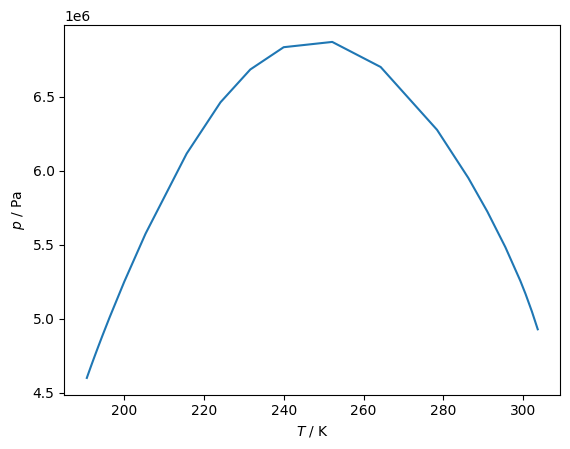GERG¶
In the GERG-2004 and GERG-2008 models, the pure fluids are modeled with high-accuracy multiparameter EOS. The model is covered exhaustively in the GERG-2004 monograph: https://www.gerg.eu/wp-content/uploads/2019/10/TM15.pdf and in the GERG-2008 paper: https://doi.org/10.1021/je300655b
The following components are supported (case-sensitive) in GERG-2004:
methane
nitrogen
carbondioxide
ethane
propane
n-butane
isobutane
n-pentane
isopentane
n-hexane
n-heptane
n-octane
hydrogen
oxygen
carbonmonoxide
water
helium
argon
and GERG-2008 adds the components:
hydrogensulfide
n-nonane
n-decane
(as well as modifying the pure component EOS for carbon monoxide and isopentane).
The interaction parameters and departure functions are not editable (by design) and the EOS parameters are hard-coded. No ancillary equations are available along with the GERG-2004 model, but you can use the on-the-fly ancillary generator of teqp.
The residual portions of these models were added in version 0.18.0, and it is planned to add the ideal-gas portions as well at a later date. The residual portion is enough for many applications like phase equilibria and critical locus tracing.
The kind is ‘GERG2004resid’ for the GERG-2004 residual model and ‘GERG2008resid’ for the GERG-2008 residual model
[1]:
import teqp
import numpy as np
import pandas
import matplotlib.pyplot as plt
teqp.__version__
[1]:
'0.22.0'
[2]:
model = teqp.make_model({'kind':"GERG2004resid", 'model':{"names": ['methane','ethane']}})
[3]:
# Note that names are case-sensitive; this doesn't work
model = teqp.make_model({'kind':"GERG2004resid", 'model':{"names": ['MeThAnE','ethane']}})
---------------------------------------------------------------------------
ValueError Traceback (most recent call last)
Cell In[3], line 2
1 # Note that names are case-sensitive; this doesn't work
----> 2 model = teqp.make_model({'kind':"GERG2004resid", 'model':{"names": ['MeThAnE','ethane']}})
File /opt/conda/lib/python3.11/site-packages/teqp/__init__.py:47, in make_model(*args, **kwargs)
42 def make_model(*args, **kwargs):
43 """
44 This function is in two parts; first the make_model function (renamed to _make_model in the Python interface)
45 is used to make the model and then the model-specific methods are attached to the instance
46 """
---> 47 AS = _make_model(*args, **kwargs)
48 attach_model_specific_methods(AS)
49 return AS
ValueError: Unable to load pure info for MeThAnE
[4]:
# Here we trace the critical locus for methane+ethane
rhovec0 = np.array([0.0, 0.0])
ifluid = 0
T0 = model.get_Tcvec()[0]
rhovec0[ifluid] = 1/model.get_vcvec()[0]
trace = model.trace_critical_arclength_binary(T0=T0, rhovec0=rhovec0)
df = pandas.DataFrame(trace)
plt.plot(df['T / K'], df['p / Pa'])
plt.gca().set(xlabel='$T$ / K', ylabel='$p$ / Pa');

[5]:
model = teqp.make_model({'kind':"GERG2004resid", 'model':{"names": ['methane']}})
[6]:
# Build an on-the-fly ancillary equation
# (not as accurate as the specialized ones, but works acceptably in many cases)
anc = teqp.build_ancillaries(model, Tc=model.get_Tcvec()[0], rhoc = 1/model.get_vcvec()[0], Tmin=60)
# And then use the dynamic ancillary to calculate VLE at 100 K
T = 100 # K
rhoL, rhoV = model.pure_VLE_T(T, anc.rhoL(T), anc.rhoV(T), 10)
rhoL, rhoV, 'mol/m^3 for liquid and vapor'
[6]:
(np.float64(27361.12577999801),
np.float64(42.046298502526746),
'mol/m^3 for liquid and vapor')